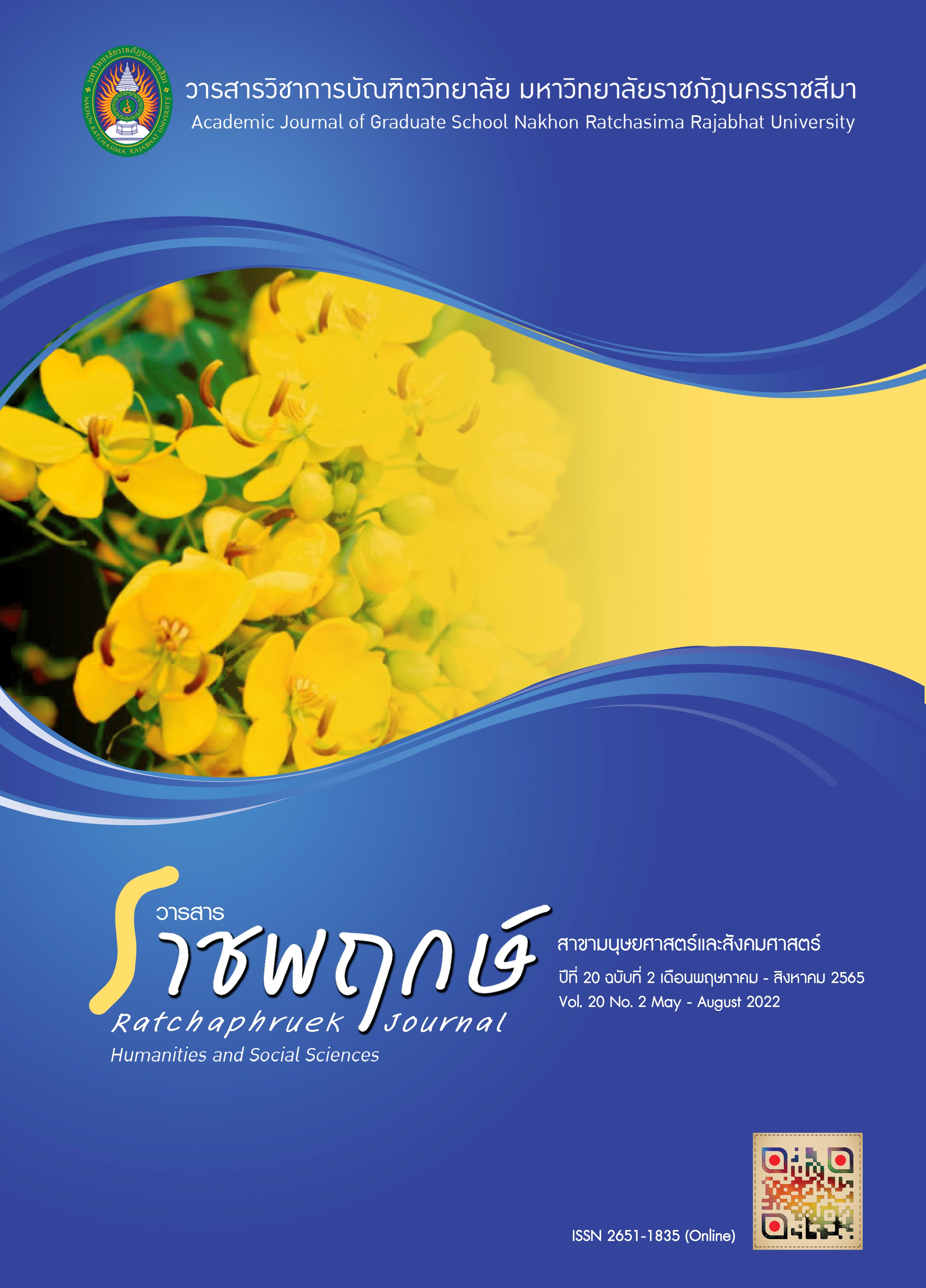ผลของโปรแกรมส่งเสริมการรับรู้ความสามารถแห่งตนที่มีต่อจิตสาธารณะของนักเรียนชั้นมัธยมศึกษาปีที่ 2
Main Article Content
บทคัดย่อ
การวิจัยนี้มีวัตถุประสงค์เพื่อ 1) เพื่อเปรียบเทียบจิตสาธารณะของนักเรียนกลุ่มทดลอง ก่อนและหลังการทดลอง 2) เพื่อเปรียบเทียบจิตสาธารณะหลังการทดลองของนักเรียน ระหว่างกลุ่มทดลองกับกลุ่มควบคุม กลุ่มตัวอย่างที่ใช้ในการวิจัย ได้แก่ นักเรียนชั้นมัธยมศึกษาปีที่ 2 ภาคเรียนที่ 2 ปีการศึกษา 2563 จำนวน 87 คน จากนักเรียนทั้งหมด 806 คน ซึ่งได้มาโดยการสุ่มแบบกลุ่ม แล้วจับสลากเป็นกลุ่มทดลอง 44 คน และกลุ่มควบคุม 43 คน เครื่องมือที่ใช้ในการวิจัย ประกอบด้วยโปรแกรมส่งเสริมการรับรู้ความสามารถแห่งตน โดยจัดกิจกรรมทั้งหมด 5 ครั้ง ในการจัดการจัดกิจกรรมแต่ละครั้งจะใช้เวลา 2-4 ชั่วโมงต่อสัปดาห์ รวมทั้งสิ้น 12 ชั่วโมง และแบบวัดจิตสาธารณะ จำนวน 25 ข้อ สถิติที่ใช้ในการวิเคราะห์ข้อมูล ได้แก่ ค่าเฉลี่ย ส่วนเบี่ยงเบนมาตรฐาน และการทดสอบค่าที ผลการวิจัย พบว่า หลังการทดลอง นักเรียนกลุ่มทดลองมีจิตสาธารณะสูงกว่าก่อนการทดลอง อย่างมีนัยสำคัญทางสถิติที่ระดับ .01 และนักเรียนกลุ่มทดลอง มีจิตสาธารณะสูงกว่านักเรียนกลุ่มควบคุม อย่างมีนัยสำคัญทางสถิติที่ระดับ .01
Article Details

อนุญาตภายใต้เงื่อนไข Creative Commons Attribution-NonCommercial-NoDerivatives 4.0 International License.
เอกสารอ้างอิง
ดวงดาว พรีพรม. (2558). การศึกษาจิตสาธารณะของนักเรียนชั้นมัธยมศึกษาปีที่ 3 สังกัดสำนักงานเขตพื้นที่การศึกษาประถมศึกษานครราชสีมา เขต 6 (วิทยานิพนธ์มหาบัณฑิต, มหาวิทยาลัยราชภัฏนครราชสีมา).
ดวงมณี วรรณสุทธิ์. (2552). การพัฒนาจิตสาธารณะสำหรับนักเรียนช่วงชั้นที่ 4 (วิทยานิพนธ์มหาบัณฑิต, มหาวิทยาลัยมหาสารคาม).
นรรัชต์ ฝันเชียร (2562). จิตอาสาพัฒนาเด็กไทย. สืบค้นเมื่อ 15 มิถุนายน 2563 จาก https://www.trueplookpanya.com/blog/content/72058/-blog-teaartedu-teaart-
นิตยา รามศิริ. (2560). ได้ศึกษาการเสริมสร้างจิตสาธารณะของนักเรียนชั้นมัธยมศึกษาตอนต้น (วิทยานิพนธ์มหาบัณฑิต, มหาวิทยาลัยศรีนครินทรวิโรฒ).
ประยุทธ ไทยธานี. (2555) แรงจูงใจในการเรียน. นครราชสีมา: มหาวิทยาลัยราชภัฏกลุ่มภาคตะวันออกเฉียงเหนือ.
พรทิพย์ มนตรีวงศ์. (2554). การพัฒนาจิตสาธารณะในนักเรียนชั้นมัธยมศึกษาปีที่ 1 ด้วยการให้คำปรึกษากลุ่มแบบพิจารณาเหตุผล อารมณ์และพฤติกรรม (วิทยานิพนธ์มหาบัณฑิต, มหาวิทยาลัยบูรพา).
ภาสุดา ภาคาผล. (2556). ผลของการจัดการเรียนรู้แบบโครงงานในวิชาสังคมศึกษาโดยใช้กิจกรรมการบริการสังคมที่มีต่อมโนทัศน์และพฤติกรรมจิตสาธารณะของนักเรียนมัธยมศึกษาปีที่ 1 (วิทยานิพนธ์มหาบัณฑิต, จุฬาลงกรณ์มหาวิทยาลัย).
มูลนิธิยุวพัฒน์. (2562). สุขที่ได้ให้. สืบค้นเมื่อ 15 มิถุนายน 2563, จาก https://www.yuvabadhanafoundation.org/th
วัชรียา เขียนนอก. (2554). ปัจจัยคัดสรรที่ส่งผลต่อจิตสาธารณะของนักเรียนระดับชั้นมัธยมศึกษาตอนต้น โรงเรียนขยายโอกาสทางการศึกษา สังกัดสำนักงานเขตพื้นที่การศึกษาประถมศึกษานครราชสีมา เขต 1 (วิทยานิพนธ์มหาบัณฑิต, มหาวิทยาลัยราชภัฏนครราชสีมา).
สุนทรี จูงวงศ์สุข. (2548). การใช้กระบวนการสิ่งแวดล้อมศึกษาเพื่อสร้างเสริมนิสัยจิตสาธารณะของนักเรียนชั้นมัธยมศึกษาปีที่ 1 โรงเรียนสาธิตมหาวิทยาลัยเชียงใหม่ (วิทยานิพนธ์มหาบัณฑิต, มหาวิทยาลัยเชียงใหม่).
ศิริธร ศรีจำนงค์. (2557). การพัฒนาหลักสูตรเพื่อเสริมสร้างจิตสาธารณะสำหรับนักเรียนมัธยมศึกษาตอนต้น ตามแนวจิตตปัญญาศึกษา (วิทยานิพนธ์มหาบัณฑิต, มหาวิทยาลัยมหาสารคาม).
อภิเชษฐ จันทนา. (2553). ผลของการใช้กระบวนการกลุ่มเพื่อพัฒนาจิตสาธารณะของนักเรียนชั้นมัธยมศึกษาตอนต้น โรงเรียนบ้านโป่งขุนเพชรพัฒนา สำนักงานเขตพื้นที่การศึกษาชัยภูมิ เขต 3 (วิทยานิพนธ์มหาบัณฑิต, มหาวิทยาลัยขอนแก่น).
Bandura, A. (1977). Self-Efficacy: Toward a unifying theory of behavior change. Psychological Review, 84(2), pp. 191-215.
Bandura, A. (1986). Social foundation of though and action: A social cognitive theory. New Jersey: Prentice-Hall.
Cardak, O. & Dikmenli, M. (2017).Preservice Teachers' Perception Levels Concerning Consumer Environmental Consciousness.Journal of Education in Science, Environment and Health, 3(2), pp.157-164.
Lavedores, A. N., Escobedo, P. S. & Sosa, J. P. (2017).Academic Self-Efficacy of High Achieving Students in Mexico.Journal of Curriculum and Teaching, 6(2), pp. 84-89.
Pietsch, J., Walker, R. A. & Chapman, E. (2003).The Relationship Among Self-Concept and Performance in Mathematics During Secondary School. Journal of Education Psychology, 95(3), pp. 589-603.


